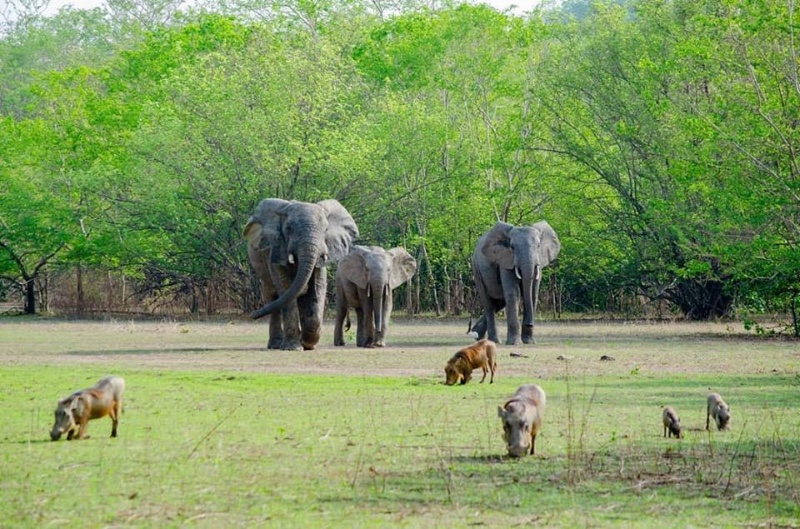Ghana is a land of plenty; a land rich with precious minerals, fertile lands and gold. The country has lakes, dams and rivers which are of pride to the citizens. Oh, galamsey has stripped the beauty off most of the rivers though. Just letting you know in case you thought all the rivers were still virgins. With all the beauty splashed across the country from Accra to Paga and Elubo to Aflao, tourist sites abound, offering flesh and life to a huge but underexploited tourism industry.
In today’s article, we look at five national parks that you should visit if you have not done so yet. And for people visiting the country, you should put this on your destinations list as well.
Kakum National Park, Central Region
Of course, it would be sinful to start from anywhere else but the globally famed Kakum National Park. Established nearly a century ago in 1931, the Kakum National Park is located near Abrafo and about 33 kilometres north of Cape Coast, the regional capital. The park covers 375 square kilometres (145 sq mi) and is one of three parks in Africa to have a canopy walkway stretching at least 200 metres. The park also is home to several species including endangered species such as Diana monkey, giant bongo antelope, yellow-backed duiker and African elephant.
Bia National Park, Western Region
Located at Bia in the Western Region of Ghana, the Bia National Park is part of twin conservation called the Bia National Park and the Bia Resource Reserve and covers an area of 563 square kilometres. The Bia River and its tributaries flow through the forest and drain at the Ivory Coast side of the area. Bia Park was created just four years after the establishment of Kakum Park and named after the Bia River which drains the area. The park was made an official national park in 1974 by which time farming activities in the area had already consumed much of the original vegetation. Human activities such as farming and logging in the area have since been stopped since 1975 and in 1985, the area was declared as a biosphere reserve and a UNESCO World Heritage Site.
You will enjoy the scenery when you visit here with over 62 species available in the forest including 10 primate species. The White-breasted guinea fowl, Black-collared lovebird, Cassin’s hawk Eagle, Honeyguide greenbul and Black-headed oriole are part of the over 189 bird species you will see when you visit. Are you spiritual? Then prepare some gifts and experience some inner peace when you give gifts to the gods at the Apaso, a cultural park located near two pools in the reserve. You will also see the Agama Africana and the smallest of the three living elephant species in the world, the African forest elephant do their things in the reserve.
Mole Nationoal Park, Savannah Region
The Mole National Park is located in the Savannah Region of Ghana and can be accessed through Larabanga. Oh, yes you read this right, Larabanga, where the famous ancient mosque is located. In 1958, the land for the park was set aside as a wildlife refuge. Over a decade later, the land was made a national park after the few human settlements within the land were relocated.
Mole is blessed with so much and it has over 93 mammal species that include huge ones such as hippos, buffalo, and warthogs. Also, you will find kob, defassa waterbuck, roan, hartebeest, oribi and the bushbuck. Do you think you got enough? Don’t step out yet, entertain your eyes by watching black-and-white colobus monkeys, the green vervet, patas monkeys and the like have fun at the park. Your package does not end there as you will also be able to see some of the 33 reptile species and over 344 bird species. Have fun visiting Mole.
In addition, Mole Park is the largest national park in Ghana covering over 4,840 square kilometres.
Digya National Park, Bono East
Ghana’s oldest and second largest national park is the Digya National Park which was created in 1900 and given national park status in 1971. The park shares borders with the largest man-made lake in the world, Lake Volta. It is bordered on three sides; north, east and south by the lake. Digya National Park covers an area of 3,743 square kilometres. It has about six primate species and over 236 species of birds living there.

Bui National Park, Bono /Savannah Region
You might have heard about the Bui Dam but that was only a recent addition to the beauty in the area. The Bui National Park was part of the number of parks that were made national parks in 1971. It covers an area of 1821 square kilometres and is divided into two by the Black Volta leaving one part in the Bono Region and the other in the Savannah. Endangered monkey species such as black and white colobus monkeys are present and several bird species are also present. However, the park is notable for its large hippotamus population. So if you are a fan of that beastly mammal, take a short trip to the Bono region. At Techiman, Nsawkaw or Wenchi, you would easily get to Bui Park.
Well, if you are happy with this info, how about you leave a comment to let us know you love it? You should also share with others so they can hear about these beautiful parks in Ghana.
Discover more from afkmediaonline
Subscribe to get the latest posts sent to your email.




























+ There are no comments
Add yours